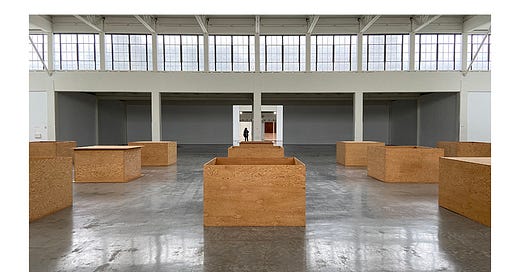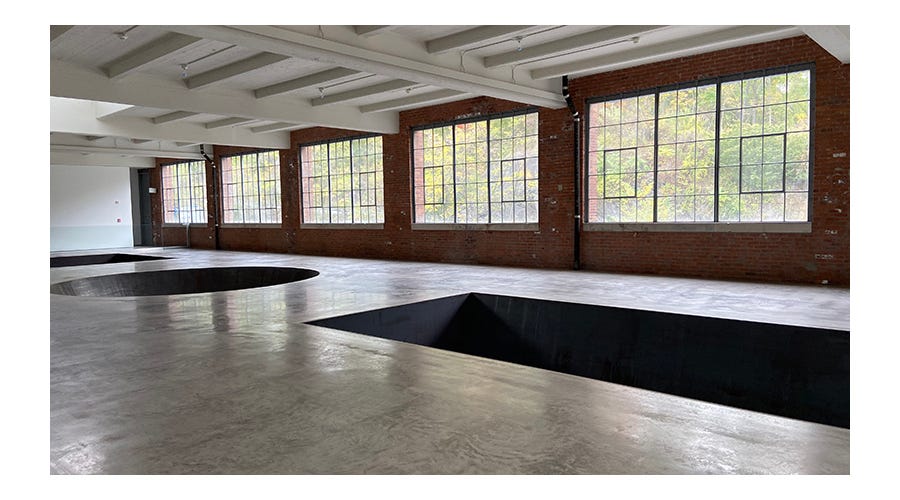Hi folks! Thanks for signing up :) Over the next few months I’ll be sharing my progress with The Artist’s Way, a new age-y self-help book written in the ‘90s that a lot of people talk about but rarely end up following. You can read more context about the decision to start the twelve-week program here.
I was excited to start The Artist’s Way on a week that I already had vacation planned. The timing of delving into new practices to “initiate my creative recovery” felt serendipitous, aligning with my first solo travel plans to visit Dia:Beacon and hike amid fall foliage.
In week 1, titled “Recovering a Sense of Safety”, Julia Cameron focuses on the need to feel safe in order to explore one’s creativity with less fear. She introduces the concept of shadow artists, those of us who surround ourselves with artists and art (whether in our careers or with our partners and friends) but have not had the support or safety to explore our creativity. This immediately resonated with me, particularly my tendencies to act in the most practical or financially secure manner (which is not necessarily bad or shameful—I would argue it is pretty necessary for survival and comfort).
Very often audacity, not talent, makes one person an artist and another a shadow artist—hiding in the shadows, afraid to step out and expose the dream to the light, fearful that it will disintegrate to the touch.
Cameron claims that the shadow artist is afraid to take themselves seriously. How does one know they’re an artist? The beginning artist does not know—there is no substantial evidence—but they find themselves with deep urges and desires to create. I recalled a time this summer that I journaled about an intuition that I had a special voice or gift to provide, but feeling like I hadn’t tapped into the source yet. Writing this down then felt embarrassing and egotistical; it still feels that way now. Seeing myself in the description of the shadow artist, I began to feel comforted and persuaded by Cameron’s words encouraging me to be gentle with myself and nurture my artist child.
The chapter goes on to emphasize going gently and slowly on the journey to creative recovery. Doing otherwise will trigger our harsh judgments and perfectionism toward our early artistic works. We also must recognize our either/or thinking: beliefs such as “I can either be financially successful or an artist.” How many of us believe this and use it as a creative block for ourselves? Black and white, this or that type of thinking comes up frequently in my therapy sessions and I found it humorous to see another either/or thought pattern of mine surface within this chapter.
Morning Pages
After the first day of trying out morning pages, I noted that I took an average of 30 minutes to finish and made sure to block out at least an hour before I had to get going in the morning. I surprised myself with my commitment to this routine when I woke up at 6:30 AM on Thursday to squeeze in morning pages before jumping on a work software deployment at 7. I was able to write morning pages all seven days this week without looking at my phone or any other distractions beforehand.
Converting Blurts to Affirmations
Cameron describes blurts as statements or thoughts that flag personal negative core beliefs. As an initial exercise, I wrote down quick bullet points of blurts related to creativity (e.g. “I don’t write every day”) and converted these negative thoughts to affirmations (“I am willing to let myself create”).
After writing my morning pages each day, I added a short list of affirmations that were the opposite of blurts I had written. Converting the incoherent blurts that surfaced in my scrawly handwriting into positive affirmations felt like a fun, hopeful exercise, though cheesy at times. Being able to identify and word the affirmation in opposition to the blurt became easier to do as the week went on. About half of these were related to creativity or negative beliefs around my own capability; the others had to do with my relations to others.
Artist Date
On Friday afternoon, shortly after arriving at Beacon and dropping off my bags at my Airbnb, I walked a leisurely twenty minutes to Dia:Beacon (for anyone visiting from NYC, Dia is a few minutes walking distance from the Beacon Metro North stop—a very easy visit). The space used to be a Nabisco box-printing factory, which can be seen in the museum’s industrial architecture. Most of the viewing areas on the main floor had skylights, brightening up the space with natural light and providing an optimal atmopshere for viewing the contemporary art housed inside. I found myself repeatedly admiring the presentation of art in such an airy and well-lit space. Light is so important—artists of all people know this!
At Dia, each gallery is designed to house the works of one artist. Most of these works are much larger than your average painting on a wall—there were sculptures, fluorescent lights, and paintings spanning multiple walls. Because the method of viewing differed from the usual “stay close to the wall and read the placards” tactic, I found that I was getting distracted and losing focus. Who made what? Where was who? Could I appreciate art unarmed with knowledge of the work or artist?
Once I found the placards on the walls of each gallery, I was able to immerse myself. Dia’s placards are subtle, practically unnoticeable if you aren’t looking, but upon pulling out the laminated paper there is a wealth of information, from the artist’s biography to the inspiration and purpose behind the displayed artworks. Learning the context behind art is my favorite aspect of browsing a museum. It distinguishes passively judging the art, looking for visually pleasing color combinations or impressively crafted works, from viewing the art from the artist’s point of view. Having the artist context helps me, the viewer, more deeply consider the personal meaning and goal behind the work rather than forming opinions based solely on aesthetic or feeling.
With contemporary art this feels especially important. With Michael Heizer’s North, East, South, West (above), at first glance I saw geometric shapes carved out of the ground. I was unable to see with my eyes how deeply these “negative sculptures” went (or what even negative sculptures were!) until I read more about the artist. These cubes, cone, and trough go twenty feet deep into the gallery grounds. Thinking of volume as absence rather than presence along with his ability to create awe with his large-scale works through negative space allowed me, at least momentarily, to see in a different way.
Reflection
Throughout this first week I notice that I am feeling more content. Whether that’s from following through on a routine thereby showing up for myself every day or simply getting away from the city, I can’t be too sure. I still don’t fully trust myself to finish twelve weeks of morning pages and solo artist dates without pause, but I try not to think about this too much.






